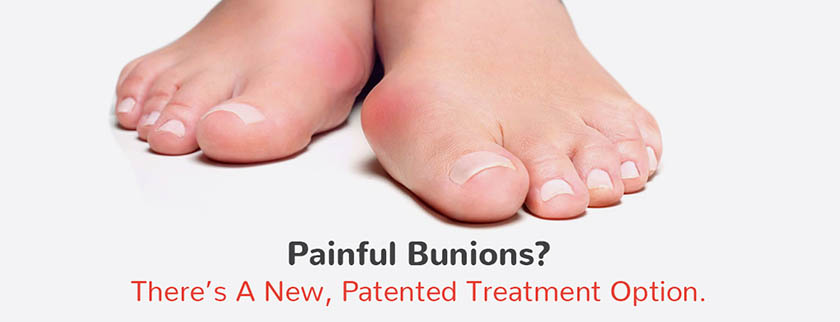
The Foot & Ankle Center provides the very latest in bunion treatments, including Lapifuse® and Lapiplasty® 3D Bunion Correction. These new techniques fix the root cause and get you back on your feet more quickly than traditional bunion treatments.
We are Richmond's first Center of Excellence for Lapiplasty 3D Bunion Correction — and one of only five in Virginia!
Are Bunions Limiting Your Activities and Lifestyle? Bunions can be very painful. With each step, your entire body weight rests on that bunion. Ouch! A common misconception about a bunion is that it is an overgrowth of bone that can simply be "shaved off". In reality, bunions are complex deformities caused by an unstable joint.
Lapiplasty ® 3D Bunion Correction: Relief is here. Now, there's a new, patented treatment for bunion correction – Lapiplasty 3D Bunion Correction. The Foot & Ankle Center is the first medical practice in Richmond to offer this exciting new treatment option which does more than simply remove "the bump"; it addresses your bunion in three dimensions to correct the root of the problem. Advanced fixation technology is used to secure the correction in place, allowing patients to walk within days of surgery. 1
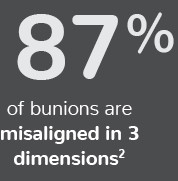
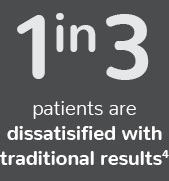 Why Was Lapiplasty 3D Bunion Correction Developed? For 87% of people with bunions, traditional surgery has failed to get to the
true source of the problem – a 3-dimensional deformity caused by an unstable
joint. 2 This is why many
people who have had traditional surgery have had their bunions
return. 3 In fact, 1 in 3
patients have been left dissatisfied with their surgical outcome in the past
and up to 70% of those treated have had their bunion return. 4
Why Was Lapiplasty 3D Bunion Correction Developed? For 87% of people with bunions, traditional surgery has failed to get to the
true source of the problem – a 3-dimensional deformity caused by an unstable
joint. 2 This is why many
people who have had traditional surgery have had their bunions
return. 3 In fact, 1 in 3
patients have been left dissatisfied with their surgical outcome in the past
and up to 70% of those treated have had their bunion return. 4
Traditional Surgery Is A 2D Solution for A 3D Problem. Traditional bunion surgery has been limited to an incomplete, two-dimensional (2D) approach to correction; cutting the bone in half and pushing the top part over to reduce the appearance of the bump. This 2D "cut and shift" approach primarily addresses the bunion's symptoms, not the root cause – the unstable foundational joint – leaving the bunion significantly more likely to come back to some degree. 3
Here is a comparison of traditional 2D bunion treatment and the new 3D Lapiplasty Procedure:
The Old Way:
Traditional 2D Procedure
Traditional 2D surgery is like trying to fix the Leaning Tower of Pisa by cutting it and shifting it — the bump is shaved, but the root of the problem is not corrected.
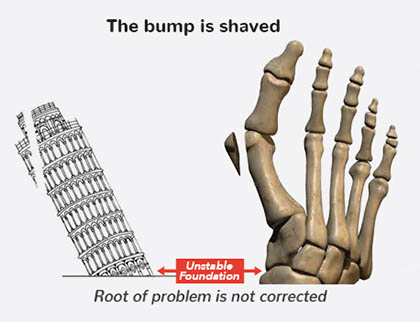
The New Way:
Lapiplasty 3D Bunion
Correction
Lapiplasty 3D Bunion Correction actually addresses the unstable foundation, by rotating it back into position and permanently securing it. The entire bone is returned to normal alignment and secured.
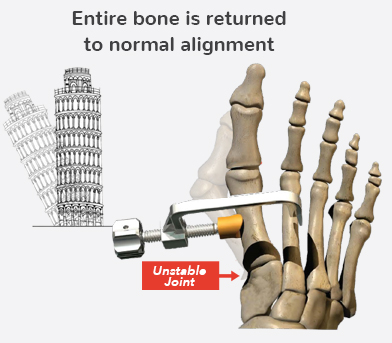
Walk Within Days After Surgery. The Lapiplasty Procedure uses two low-profile (petite), anatomically-shaped titanium plates to permanently secure the unstable foundation of your corrected bunion. This provides buttressing on multiple planes and allows you to walk within days of surgery. 1 Think of this in terms of how a basketball player might hold a basketball. When a player tightly grips the ball with both hands, the ball is held more securely than if only one hand is used. Unlike other surgical approaches, the Lapiplasty® Procedure utilizes two plates for this very reason – "Two plates are better than one". 7

What to Expect In Terms Of Recovery: The patented titanium plating technology used with the Lapiplasty Procedure enables patients to bear weight on their foot early. 1 The ability to do so can dramatically improve your recovery process, allowing you to walk up to 6-8 weeks earlier than with the more traditional Lapidus approach (which was previously the only option for addressing the unstable joint). Being able to walk in a surgical boot, as opposed to being completely non-weight bearing (in a cast with scooter or crutches) for 6-8 weeks, means that you will be getting back to a better quality of life faster; may return to most occupations more quickly; and will be less inconvenienced by bunion surgery. 8
What Patients Around the Country Are Saying About Lapiplasty 3D Bunion Correction
Below are quotes from actual Lapiplasty patients. As with any medical treatment, individual results may vary. These results are specific to these individuals only.
"I have had two surgeries. This time was so much easier than the first time. I had very little pain and I could walk almost right away!" — Tiffany from West Virginia
"My sister and I both had bunion surgery at the same time, but she can't understand why I can wear my heels with no problem and how I recovered so fast." — Amanda from Illinois
"My husband and I both felt my foot looked so much better after my Lapiplasty surgery. Much better than expected." — Carrie from Colorado
Frequently Asked Questions About Lapiplasty 3D Bunion Correction
Below are some questions patients commonly ask and their respective answers:
- How long does it take to recover from a Lapiplasty Procedure? Patients are typically walking within days of surgery. Patients can return to most occupations within days to a couple of weeks, wearing a surgical boot. Within six weeks, you can expect to be walking in comfortable shoes such as tennis shoes, however you should not plan on any high-impact activities for three to four months. Short shopping trips and leisurely strolls are examples of the types of activities that should be fine at this point. Around the four-month mark post-op, you should be able to return to most activities and most shoe wear. 9
- Can I wear fashionable shoes again? The Lapiplasty Procedure allows most patients to return to their desired shoes. Of course, some fashionable shoes can be painful (even with a normal foot!), so results can vary from person to person and shoe to shoe.
- Can I play sports after the Lapiplasty Procedure? Yes, there are no permanent activity limitations after the Lapiplasty Procedure. Most patients are able to return to most activities after the bones have completely healed at approximately four months. 9
- Can the Lapiplasty Procedure be performed on someone who has previously had traditional surgery? Yes, the Lapiplasty Procedure is an option that can be utilized by your doctor when a revision is required. Even if previously treated, patients can experience the same benefits from Lapiplasty – with a permanently secured foundational joint this time around.
- I’ve heard the term "reproducible" used when describing the Lapiplasty Procedure. What does that mean? "Reproducible" means that a procedure is easily repeatable with expected results. The Lapiplasty Procedure utilizes precision, patented instrumentation designed to take the guesswork and "eyeballing" out of bunion surgery; helping ensure your surgeon can get reliable results over and over.
-
Can the Lapiplasty Procedure be performed as an outpatient procedure
and how long does it last? Yes, Lapiplasty surgeries are performed as outpatient procedures.
Typically, the surgery will last just under an hour. If your doctor is
performing any additional procedures at the same time, the surgery may take
longer.
Meet your certified Lapiplasty surgeons at The Foot & Ankle Center:
Learn More About Bunions and Bunion Treatment.
References
1 Smith B, Santrock R,
Dayton P, Hatch D. Immediate Weight Bearing after Biplanar Plantar Fixation of
Lapidus: A Multi-Centered Study. 2017 AOFAS Annual Meeting, Seattle, WA.
2 Kim Y, Kim JS,
Young KW, et al. Foot Ankle Int. 2015. 36:944-52.
3 Okuda R, Kinoshita
M, Yasuda T, et al. JBJS. 2007. 89:2163-72.
4 Jeuken RM, et al.
Foot Ankle Int. 2016. 37:687-95.
5 Dayton P, Ferguson J, Hatch D, Santrock R, Scanlan S,
Smith B. 2016. Comparison of the Mechanical Characteristics of a Universal
Small Biplane Plating Technique Without Compression Screw and Single Anatomic
Plate With Compression Screw. J Foot Ankle Surg. 55:567-71.
6 Dayton P, Ferguson
J, Hatch D, Santrock R, Scanlan S, Smith B. Biplanar Plating with an Anatomic
Tension-Side Plate for Lapidus Fusion: Improved Biomechanical Properties.
Accepted for presentation at 2017 AOFAS Annual Meeting, Seattle, WA. Submitted
for publication.
7 Dayton P, Ferguson J, Hatch D, et al.. J Foot Ankle
Surg. 2016. 55:567-71.
8 Catanzariti, AR, et al. Jrnl Foot Ankle Surgery,
38:325-32.
9 MacMahon, A, et al. Foot Ankle Int. 2016. 37: 378-85.
